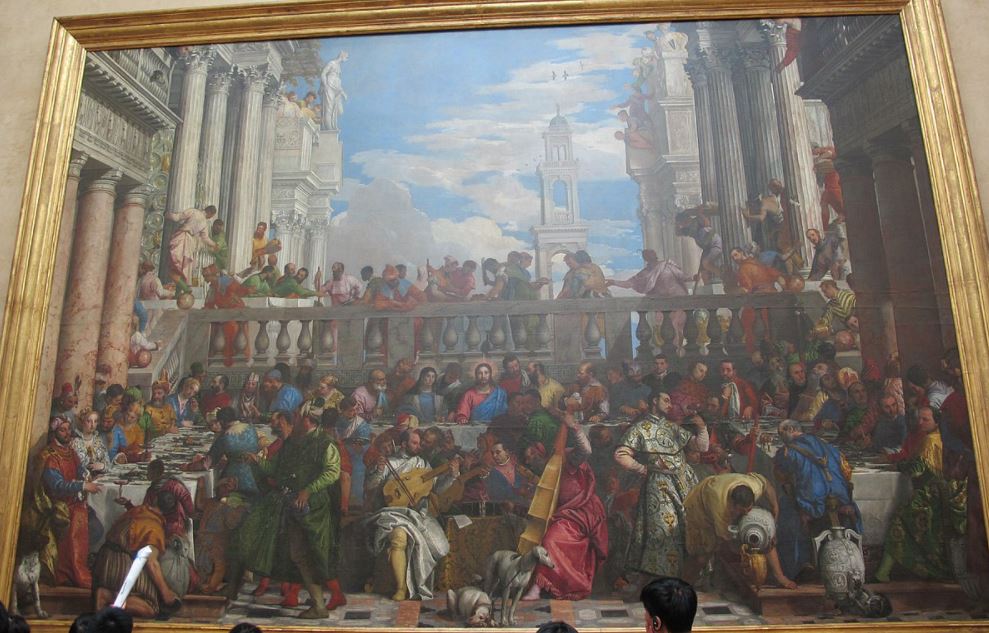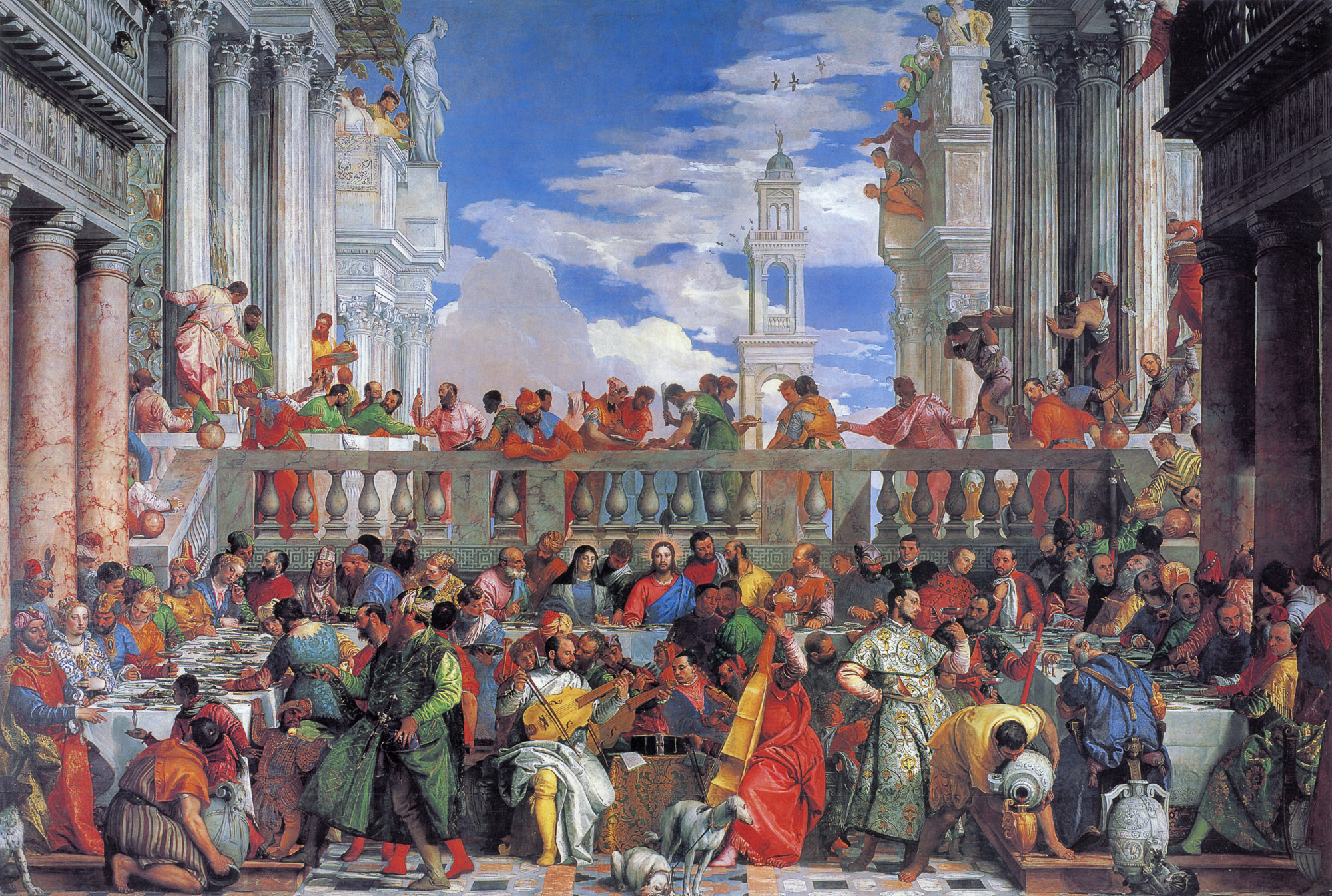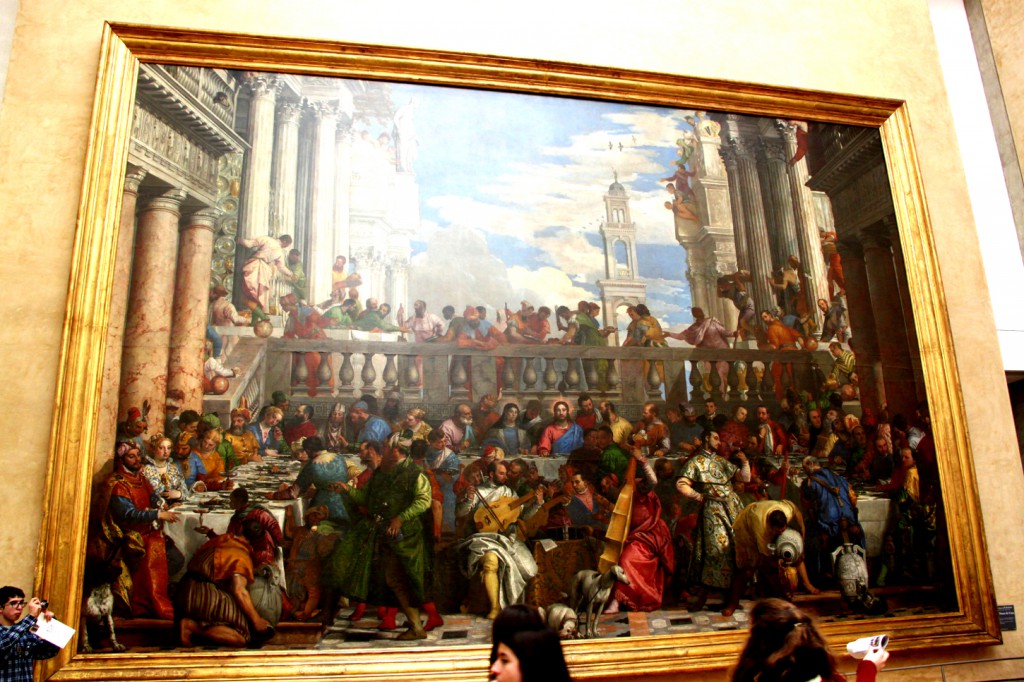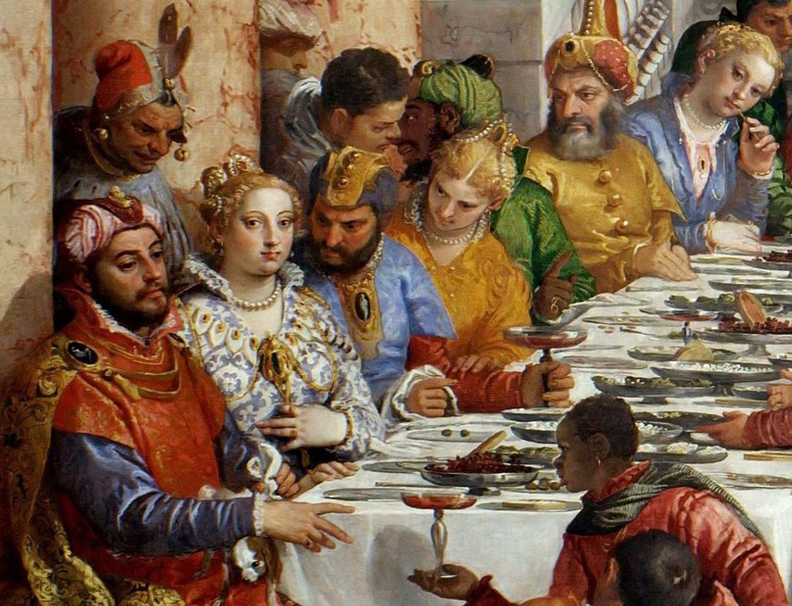
The Wedding At Cana By Veronese Top 12 Facts
modifier - modifier le code - modifier Wikidata Les Noces de Cana est un tableau réalisé par le peintre vénitien Paul Véronèse en 1563 sur le thème iconographique des Noces de Cana , il est exposé au musée du Louvre , à Paris . Histoire [modifier | modifier le code] Le tableau est commandé le 6 juin 1562 par le bénédictin Paul du monastère San Giorgio Maggiore , à Venise . Il est.

Nozze di Canà Paolo Veronese Louvre So many people in front of it
la Joconde in Le Louvre. To finally get at this cult icon of the Da Vinci code, hundreds of thousands of visitors have to enter through two doors that are separated by a huge framed painting, Veronese's Nozze di Cana, a rather dark giant of a piece that directly faces the tiny Mona Lisa, barely visible through her thick

The Language of the Banquet Reconsidering Paolo Veronese’s Wedding at
Les Noces de Cana. 1500 / 1600 (XVIe siècle) Paolo Caliari, dit Veronese. Italie, École de. INV 142 ; MR 384. Département des Peintures. Actuellement visible au Louvre. Salle 711. Aile Denon, Niveau 1.

The Tumbrel Diaries The Wedding at Cana
Wedding at Cana also known as Wedding Feast at Cana and Le Nozze di Cana is an oil painting by Michael Damaskinos.He was active during the second half of the 16th century in Heraklion, Sicily, Venice, and different parts of Italy.Over 100 works are attributed to the artist. Most of his work resembled the Greek mannerisms prevalent at the time also known as maniera greca.
.jpg/1200px-Veronese%2C_The_Marriage_at_Cana_(1563).jpg)
Nozze di Cana (Veronese) Wikipedia
At over 6 metres high and almost 10 metres wide, The Wedding Feast at Cana is the biggest painting in the Louvre. It depicts an extraordinary banquet with a crowd of some 130 different characters in a blaze of light and colour. Veronese painted the scene for the refectory of the monastery on the island of San Giorgio Maggiore in Venice.

Probabile autoritratto di Paolo Veronese, particolare delle Nozze di
mannerism. This is a faithful photographic reproduction of a two-dimensional, public domain work of art. The work of art itself is in the public domain for the following reason: ". This photographic reproduction is therefore also considered to be in the public domain in the United States. Reuse of PD-Art photographs.

The Wedding Feast at Cana, the largest painting at the Louvre Museum
"By 1705, Paolo Veronese's Wedding Feast at Cana / Nozze di Cana, a sprawling 32-foot-long painting depicting the famed biblical episode, was drawing so many visitors that the Bendectine monks at St. Mark's Basilica in Venice had to start capping how many people could see in a given span of time.What those monks didn't know is that, less than 100 years later, the painting would be.

Una scena biblica trasferita in un banchetto veneziano rinascimentale
Good article about the painstaking fabrication of an exact replica of the painting "Le Nozze Di Cana" by Veronese, which is currently in the Louvre in Paris, having been removed in 1797 from the Fondazione Cini in Venice. The replica now hangs in Venice in it's rightful location. An extremely advanced, painstakingly complex procedure was.

Paolo Veronese, Nozze di Cana The Wedding Feast at Cana , Musée du
The Wedding Feast at Cana (Nozze di Cana, 1562-1563), by Paolo Veronese, is a representational painting that depicts the biblical story of the Wedding at Cana, at which Jesus miraculously converts water into red wine (John 2:1-11).Executed in the Mannerist style (1520-1600) of the late Renaissance, the large-format (6.77 m × 9.94 m) oil painting comprehends the stylistic ideal of.

Guide To The The Louvre Museum How To Make The Most Of Your Visit
1. It was completed in the 1560s. The Wedding at Cana, also referred to as " The Wedding Feast at Cana " or " Nozze di Cana " in Italian, is a massive oil on canvas painting created by Paolo Veronese (1528-1588), one of the 3 main figures of the Venetian School of the 16th century. The work was completed in 1563 at the height of an art.

The Marriage at Cana (detail) 1563 Oil on canvas Musée du Louvre, Paris
The Wedding Feast at CanaIn 1553, Veronese was summoned to Venice where he gave free rein to his decorative talent in vast canvases that blended masterful co.

Le nozze di Cana di Paolo Veronese analisi
Paolo veronese, le nozze di cana, 1563-62, da s. giorgio maggiore a venezia, 02 musici.jpg 3,456 × 2,172; 4.57 MB.. Veronese-Marriage at Cana-Louvre.tiff 843 × 569; 1.26 MB. VeroneseCana.jpg 1,146 × 780; 590 KB. Visitors looking at Les Noces de Cana by Veronese (15577523623).

Paolo VeroneseLe nozze di Cana(dettaglio),1563,olio su tela,, 666 x
The work is now housed in the Louvre and underwent a major restoration in 1992. See the catalog for the restoration: Les Noces de Cana de Véronèse:. Habert, "Il restauro delle 'Nozze di Cana' di Veronese: qualche osservazione," 89-90. ". . . la istoria della Cena del miracolo fatto da Cristo in Cana di Galilea,.

The Wedding Feast at Cana Louvre (with this person in the picture it
The Wedding Feast at Cana (1563), by the Italian artist Paolo Veronese (1528-88), is a representational painting that depicts the biblical story of the Marriage at Cana, at which Jesus converts water to wine (John 2:1-11). Executed in the Mannerist style (1520-1600) of the late Renaissance, the large-format (6.77m × 9.94m) oil painting comprehends the stylistic ideal of compositional.

The Wedding at Cana [The Largest Painting in the Louvre, Paris] a
The Wedding Feast at Cana (Nozze di Cana, 1562-1563), by Paolo Veronese, is a representational painting that depicts the biblical story of the Wedding at Cana, at which Jesus miraculously converts water into red wine (John 2:1-11).Executed in the Mannerist style (1520-1600) of the late Renaissance, the large-format (6.77 m × 9.94 m) oil painting comprehends the stylistic ideal of.

bensozia Paolo Veronese, The Wedding at Cana
カナの婚礼 (ヴェロネーゼ) Metadata. This file contains additional information such as Exif metadata which may have been added by the digital camera, scanner, or software program used to create or digitize it. If the file has been modified from its original state, some details such as the timestamp may not fully reflect those of the.